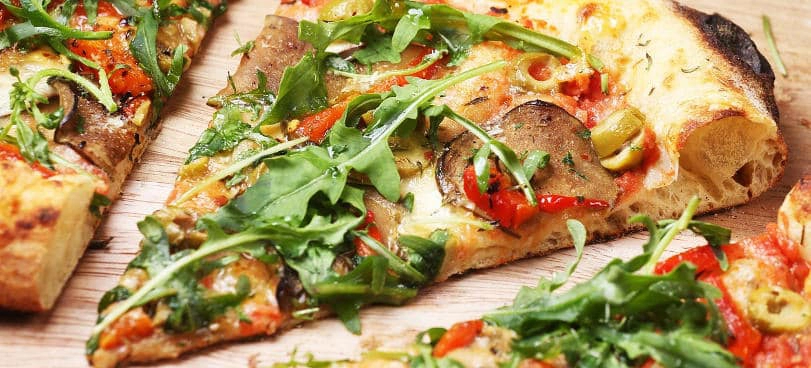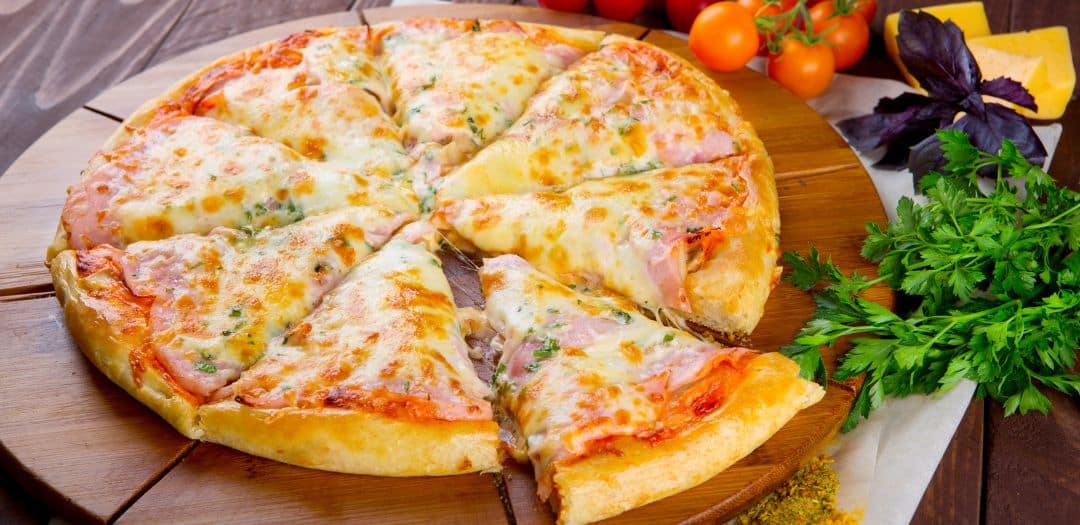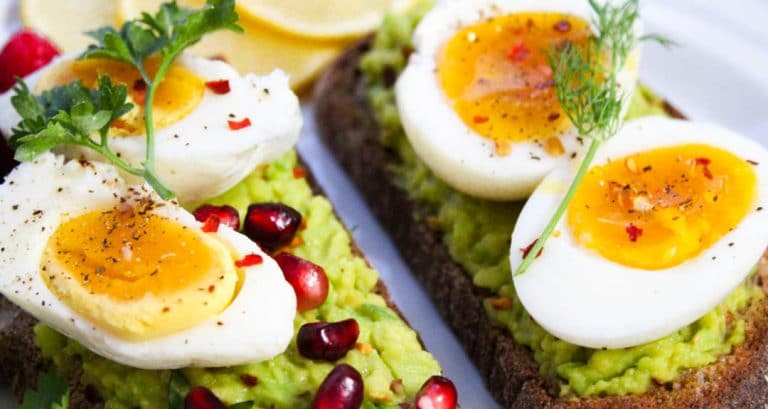Can Pizza Be Healthy? 15 Pizza Facts, Tips, and Recipes!
Thankfully, we come bearing good news: healthy pizza exists! Better yet, it can act as a wholesome meal within almost any diet!
While it’s true that traditional pizza can be full of empty calories and unhealthy fat, there are many ways to make this comfort food more nutritious.
Here we’ll give you eight practical tips to make any pizza healthier, plus two easy and delicious recipes for healthy pizza!
5 Fun Pizza Facts
Want to know a little more about pizza’s past and present before we talk about how to make it healthier?
This food has a fascinating history and has only recently spread worldwide to become immensely popular in America and abroad. Check out these five fun pizza facts!
- Pizza originated in Naples, and soldiers took it worldwide after WWII
There’s a lot of debate about the origins of this now-popular dish, but historians agree that modern pizza started around 600 BC in then-Greek Naples.
Ancient Egyptians, Romans, and Greeks ate flatbreads with olive oil and herbs – a dish we now call focaccia.
However, it was the working class of Naples that started using tomatoes and cheese. Unlike the ruling elites that favored gourmet cuisine, working-class Neapolitans subsisted on bread, tomatoes, cheese, and herbs – the perfect makings for a modern, healthy pizza!
The cheesy bread was originally sold only as street food, and it wasn’t until Italy unified in the mid-1800s that the king and queen tried pizza.
Still, pizza wasn’t popular outside Naples until after World War Two, when American and European soldiers tried pizza in Italy and brought the novel idea home.
- Americans spent over $33 billion on quick-serve pizza in 2017
As of last year, there were over 75,200 pizza restaurants in the US. In 2017 alone, we spent over $33 billion on fast-food pizzas like Pizza Hut, Dominos, and Papa John’s!
On top of that, when they conducted this survey, over 72 million of us had eaten frozen pizza in the last week. Americans love pizza.
- Green peas are the most popular pizza topping in Brazil
Some of the craziest pizza facts? Most popular pizza toppings around the world. While pepperoni and mushrooms win-out in the US, Brazilians love green peas, and Costa Ricans go for coconut.
On the other side of the world, Russians opt for fish and onions while Aussies like shrimp and pineapple. Have you tried some unusual pizza toppings? Share with us in the comments section below!
- The world’s largest pizza was 13,580.28 ft² (1,261.65 m²) … and gluten-free!
A group of Italians made the largest-ever pizza in Rome in 2012. It’s no surprise that this pie is the current record-holder, given that it was the size of a small mansion!
The pizza measured almost 13,600 ft2 in the area and was entirely gluten-free. The cooks named their creation “Ottavia.”
- New Year’s Eve is the busiest pizza delivery day of the year in the US
According to Domino’s statistics, NYE is the busiest pizza delivery day of the year. Can you guess which days take spots 2-5? They’re New Year’s Day, Super Bowl Sunday, Thanksgiving Eve, and Halloween. Apparently, we like to celebrate with pizza!
Can Pizza be Healthy?
Now that you’re thinking about pizza, here’s the real question: can pizza be healthy? Yes, it can! The trick is to be conscientious about your crust, sauce, and toppings to create the healthiest pizza possible.
Here are some tips for making a healthy pizza that you and your friends & family will love!
1. Go for a thin crust, and make it whole-grain (or vegetable)
Let’s talk calories in cheese pizza – no extra toppings.
One slice of stuffed crust pizza has about 360 calories, as compared to one slice of normal crust pizza, which has about 210 calories.
Thin-crust pizza, however, is the best option, with about 170 calories per slice. Moral of the story: thinner crust equals fewer calories! If you’re counting carbs, crust thickness is an even more relevant consideration.
If possible, choose a whole-wheat (or other whole-grain) crust. By using whole grains instead of white flour, you add healthy fiber and nutrients into your pizza crust.
Fiber is digested more slowly than simple carbs, so it promotes satiety and stabilizes blood sugar. Both of those effects support your weight loss efforts by helping you resist cravings and eat less!
If you’re feeling adventurous and want an even healthier crust, consider cauliflower pizza crust. This is a great option for people who strictly monitor their calories or carbs, and it tastes great too!
The texture is definitely unique when compared to traditional (wheat) crusts, but it’s a yummy and trendy healthy pizza option. If you’re interested, check out our healthy cauliflower crust pizza recipe below!
2. Load your pizza with veggies
It’s no secret that meat and cheese have more calories than veggies. The significant difference in calories is because vegetables are made mostly of water and a small number of carbs, while processed meats and cheese contain high amounts of fat and some protein.
So, if you’re goal is to make a healthy pizza, pile your pie high with veggies! Roasted veggies taste great as a topping and are relatively low in calories and fat.
The healthiest option is to use vegetables instead of processed meats, but even if you still use a little bit of meat, the veggies will provide fiber and vitamins that serve you well.
3. Opt for homemade sauce
Pre-made sauces are often loaded with sodium. If you have time, make a homemade tomato sauce that’s lower in salt.
Alternatively, cut up some chunks of tomato and spread the crust with a little bit (about 1-2 tbsp) of olive oil and garlic, sprinkle with Italian seasoning, and spread the tomato chunks across the pie.
Then add other toppings. This is an easy way to reduce sodium and calories but not sacrifice flavor.
Some of you may be reading this thinking, “..but pizza is supposed to have sauce!” Okay, I get it – it’s comfort food, and you don’t want to fundamentally change it.
If you’re going to use store-bought sauce, go for tomato (marinara). Alfredo is cream-based, and pesto is oil-based, so they’re typically higher in calories and fat than marinara sauce, which is based on tomatoes.
4. Take it easy with the cheese
Cheese is delicious and melty but also high in unhealthy fats.
Still, cheese can form part of a healthy diet when enjoyed in moderation. So, can pizza be healthy when it’s covered with cheese? Again, yes – as long as you keep an eye on it!
One ounce (about ¼ cup) of shredded, whole-milk mozzarella cheese has 85 calories and 6 grams of fat, 3.7 grams of which are saturated fat.
As a reminder: saturated fat is one of the bad fats that’s associated with higher LDL (bad cholesterol) and an increased risk of heart disease. The American Heart Association cautions against consuming too much saturated fat daily.
In comparison, one ounce of shredded, part-skim mozzarella has 72 calories, 4.5 grams of fat, and 2.9 grams of saturated fat.
While the difference may not seem significant on paper, the calorie and fat savings add up over time – especially if you love cheese!
Fat-free mozzarella is also available (and even lower in calories). However, if you’d rather have a little more cheese that’s lower in calories and fat-free, check it out for yourself!
Speaking of quantity… skip the “extra cheese” on your order.
Cheese tastes great but contributes lots of extra calories and fat. Instead of having cheese drip off the side of your slice, use this ingredient sparingly to give flavor and keep your other toppings in place.
5. Use lean meats
Can’t imagine your pizza without meat or are worried about getting enough protein?
Go for lean proteins to make the pie healthier! Meats like chicken, turkey, Canadian bacon, and seafood are lighter than more traditional American toppings like pepperoni, sausage, and meatballs.
Consider Hawaiian pizza (tomato sauce, cheese, pineapple, and Canadian bacon) or BBQ chicken pizza (a little BBQ sauce, cheese, chicken, peppers, and mushrooms) if you’re looking for inspiration.
6. Experiment with spices
This is common weight loss advice, but it’s a good idea. Instead of relying on meats and cheese to flavor your food, make a delicious and healthy pizza by using spices.
Common flavors for a pizza include garlic/garlic powder, Italian seasoning (basil, oregano, rosemary, and thyme), fennel, and red pepper (cayenne pepper). Depending on your healthy pizza recipe, other spices and herbs may be wonderful additions as well!
Bonus tip: recent research indicates that eating cayenne pepper (and other spicy foods) can help you lose more weight.
The spice accomplishes this feat by curbing your appetite and promoting a faster metabolism. If you can handle the heat, try adding a few extra sprinkles of red pepper to your next meal!
7. Watch your portions
Like any other food, one of the main considerations in discussing “can pizza be healthy?” is always portion control.
The ideal pizza serving is 1-2 slices, which can be complemented by a healthy side dish (like salad) if you’re still hungry.
8. Enjoy a side salad
Salad is the perfect side dish for pizza nights! Filled with veggies and nutrients and low in calories, salad is a great way to fill your plate and stomach.
When you fill up on salad, it’s much easier to say “no” to that third or fourth slice of pizza – even if it’s delicious, healthy pizza. Steer clear of sides like breadsticks or brownies that only contribute extra carbs and calories, with little added nutritional value.
When ordering (or preparing) your salad, choose garden salad instead of Caesar. The croutons, cheese, and dressing on Caesar salad make it deceptively unhealthy. Instead, go for a garden salad with lots of veggies and dressing on the side.
Healthy Pizza Recipes

Alright, now you’re prepared with plenty of tips to make any pizza healthier! The final step is a little inspiration for your next pizza night. Here are two easy and healthy pizza recipes:
Roasted Vegetable Pizza
Whether you’re buying pre-made dough or making a pizza crust from scratch, preparing some tasty vegetables to use as a topping will make your healthy pizza infinitely more appealing!
If you’re interested in an easy and healthy pizza crust to make at home, check out this whole-wheat pizza dough recipe from Eating Well.
Once you have your crust, it’s time to roast the vegetables. Cut up some of your favorite vegetables like broccoli, bell peppers, onion (red or yellow), and squash or zucchini into similar-sized, small pieces.
In a medium bowl, mix about 1 tbsp of olive oil with 1 tsp of garlic paste, plus a few generous shakes of Italian seasoning and a little bit of rosemary, salt, and pepper (or whichever spices you like best!).
Add the vegetables and toss in a bowl until lightly coated. Spread vegetables across a cookie sheet and bake at 425°F for 15-20 minutes, or until veggies soften.
Top the pizza crust with tomato sauce, a light sprinkling of part-skim mozzarella, and your roasted veggies. Bake for about 10-12 minutes, or until cheese bubbles. Remove from oven, let cool and enjoy!
Healthy Cauliflower Pizza
Healthy cauliflower crust pizza is one of the trendiest types of pizza right now and with good reason! It’s much lower calorie, very low-carb, and gluten-free.
Instead of piling toppings on top of bread, healthy cauliflower pizza allows you to top a vegetable crust.
Some supermarket chains (like Trader Joe’s) sell pre-made, frozen cauliflower crusts. However, you can also make a healthy cauliflower pizza from scratch at home!
Take a head of cauliflower, break it into florets and then pulse it in a food processor until riced. Pour the cauliflower out into a mesh basket and steam until soft.
If you don’t have a steamer, you can microwave the cauliflower (covered) for about five minutes or until soft. Let cool and then ring out the excess water. It’s best if you use a cheese towel or similar to get the most water out.
Mix steamed cauliflower with 2 eggs (or ½ cup of egg whites), ¼ cup Parmesan cheese, and your favorite Italian spices (garlic, Italian seasoning, salt, pepper, etc.). Bake for 15-20 minutes at 425°F, or until slightly golden.
Remove from the oven and top with tomato sauce, a light sprinkling of part-skim mozzarella, and your favorite healthy pizza toppings (I think that cauliflower crust makes a great base for Hawaiian pizza!).
Bake for another 10 minutes, or until the cheese starts to bubble.
What do you think? Can pizza be healthy? Do you have any other great tips about how to make a delicious, healthy pizza? Share with us in the comments section below!







It’s nice to know that roasted vegetables can also be a great topping on pizzas. I’d like to find a good pizza delivery service soon because my daughter will be having a slumber party soon. I want to make sure that I will be able to provide nutritious food to her and her friends while still retaining what could be expected from a slumber party.